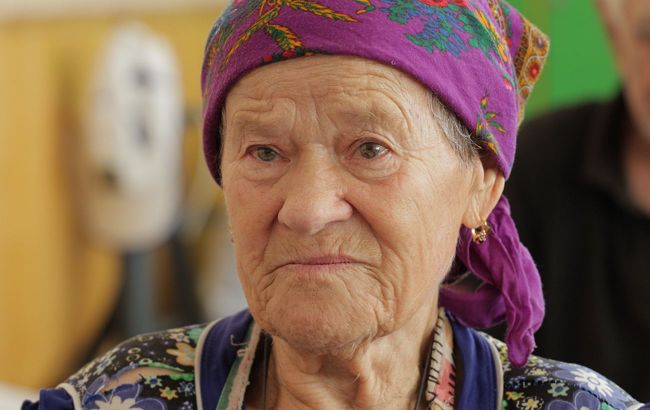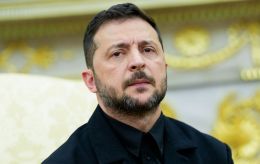City erased from the map: Donetsk refugees tell their story of escape and survival
 Oleksandra, a resident of Zolotyi Kolodiaz village, who was evacuated to Pavlohrad (Photo: RBC-Ukraine)
Oleksandra, a resident of Zolotyi Kolodiaz village, who was evacuated to Pavlohrad (Photo: RBC-Ukraine)
The transit center in Pavlohrad, where volunteers bring evacuees from the Donetsk region, recently moved to a new location. It now takes in 100–150 people a day. How the center works — read in the RBC-Ukraine report.
'There was fire all around.' First stop after evacuation
Outside the transit center, people leave bags with their belongings, while inside, a line forms — mostly elderly people. Each holds a folder of documents, their eyes filled with uncertainty.
We pass the line and walk to the end of the corridor. In one of the rooms, an elderly woman sorts through medicines. "This is for blood pressure," she explains. "The volunteers gave it to me."
Two days ago, Oleksandra and her husband were evacuated from the village of Zolotyi Kolodiaz, not far from Dobropillia. "The soldiers rescued us. Fire was burning everywhere. Rockets were flying, houses on fire. The windows blown out with their frames, the roof tiles shattered, everything destroyed," she recalls.
In August, Russian forces managed to break through the front toward Dobropillia. The village of Zolotyi Kolodiaz became the last settlement they briefly occupied. But by August 15, DeepState analysts reported that Ukraine's Defense Forces had retaken the village.
 Allа Riabtseva, coordinator of the transit center (Photo: RBC-Ukraine)
Allа Riabtseva, coordinator of the transit center (Photo: RBC-Ukraine)
During all this time, the couple had remained in the village until they were finally evacuated. "Two soldiers came in a military vehicle, the kind with bars on it. They grabbed us under the arms and threw us inside. That's how we left. We grabbed what we could. But everything else stayed there — the chickens in the yard, our Zhiguli in the garage. Everything we had is left in the village," Oleksandra laments.
She speaks about her last days at home with tears in her eyes.
"I don’t want to remember. There's nothing left to return to," Oleksandra says, pausing for a few seconds. "Maybe they'll give us something, maybe add to our pension, maybe we'll buy a small house somewhere."

Oleksandra and her husband were evacuated from Zolotyi Kolodiaz village near Dobropillia (Photo: RBC-Ukraine)
Hundred people a day. How the transit hub in Pavlohrad operates
The transit hub in Pavlohrad moved to a new location on August 26. After the breakthrough on the Dobropillia front, the number of displaced people surged sharply. The old center in Pavlohrad no longer had enough space. At first, volunteers set up extra beds and tents, but even that wasn't enough.
To ease the load, two additional centers were opened — in the Lozova (Kharkiv region) and Voloske (Dniprovskyi district) settlements. Meanwhile, Pavlohrad got a new building. It can now host 130 people, double the capacity of the previous facility.
The grounds are equipped with six heated tents with air conditioners and generators. There are also mother-and-child rooms, a cafeteria, and a shelter.
Various organizations evacuate people here from the hottest areas of the Donetsk region. In one place, newcomers can get legal, financial, and medical assistance and speak with psychologists.
"They can stay no more than three days. For those who remain while deciding where to go next, we provide three hot meals a day," says center coordinator Alla Riabtseva.
From here, people are relocated to the Vinnytsia, Khmelnytskyi, Lviv, or Kirovohrad regions. The coordinator recalls that at one point, more than 400 people were passing through the center every day. Some stayed, others just filled out paperwork and moved on. Now the flow has decreased — about 100–150 people a day.

Displaced people stay no longer than three days in the transit center (Photo: RBC-Ukraine)
'People still hold on to hope that this will end'
At the center, we meet Roman, a volunteer with the NGO East SOS, and his partner, a Labrador named Barney. Roman has been part of an evacuation crew since 2022.
"We started by evacuating people from my hometown of Sievierodonetsk. Then we moved further back as the front line shifted," Roman says. Barney joined him only six months ago. "During evacuations, he helps calm people, especially kids. He sits with them and eases the stress," Roman explains, recalling the evacuation of a child with autism.
"We thought the kid wouldn't manage a three-hour ride — with autism, being stuck in a moving, closed space is really tough. But with Barney lying at the feet, the child stayed distracted the whole way. We made it without any problems," Roman says.

Roman has been working with an evacuation crew since 2022 (Photo: RBC-Ukraine)
According to him, evacuation requests come in every day from towns and villages across the region.
"In the evenings, we analyze the situation and build safe routes," Roman adds. Without electronic warfare equipment, volunteers can currently operate only within 10 kilometers of the front line.
Still, many people refuse to leave, even as Russian forces close in. They cling to news of peace talks.
"People keep hoping things will get better, that life will go back to normal. But that's a false belief, and it's dangerous. You have to evacuate," Roman says.

Roman's loyal companion, a Labrador Barney (Photo: RBC-Ukraine)
'We've had a full-scale war since 2014'
From another room, a woman comes out and smiles at us. I'd guess she's around 70. She invites us into her temporary room but doesn't want to speak on camera.
"It's hard to recall everything I've lived through," she says. Her neighbor, Olena, starts talking to us. "I had everything. Now I have nothing," Olena adds.
Olena has been displaced twice. In 2022, she fled Avdiivka. For a while, she stayed in Zaporizhzhia, then returned to the Donetsk region, to Rodynske village near Pokrovsk. She rented an apartment there and managed to settle in. But when the front line drew closer, she had to run from the war again.
"They're wiping the city off the face of the earth," Olena says. For the past two months, she and her neighbors had been living in a basement.
In August, Russian forces came right up to Rodynske. Heavy fighting broke out on the approaches to the town. If the Russians had captured it, the village would have become a staging point for their push on Pokrovsk.
"Two months ago, the fierce battles began. All the houses are destroyed, and everything is burning. There's no communication, no water, no gas. And I have nowhere to go. My home is in Avdiivka. We've had a full-scale war there since 2014. We lived on the front line," she recalls.

During the full-scale invasion, Olena has become a displaced person twice (Photo: RBC-Ukraine)
She remembers that at first, a man from Dobropillia helped her escape.
"He was really desperate, but I'm so grateful to him," Olena says. Later, volunteers told her they had taken the "road of death." "Burned-out cars lined the road, and bodies lay there. And this was in summer, in the heat. Can you imagine what it was like?" she adds.
As for where she'll go next, Olena doesn't know yet. She says her granddaughter lives in Khmelnytskyi, so maybe there. Still, Olena doesn't want to be a burden to her family.
Others in the room join the conversation. Each of them has their own story of survival. "Only people like us can truly understand us," sums up a blonde woman sitting nearby.

